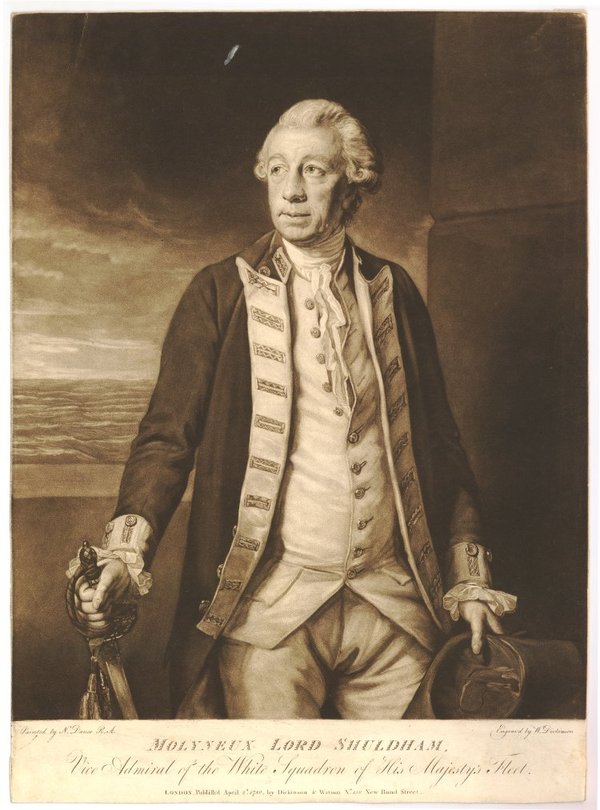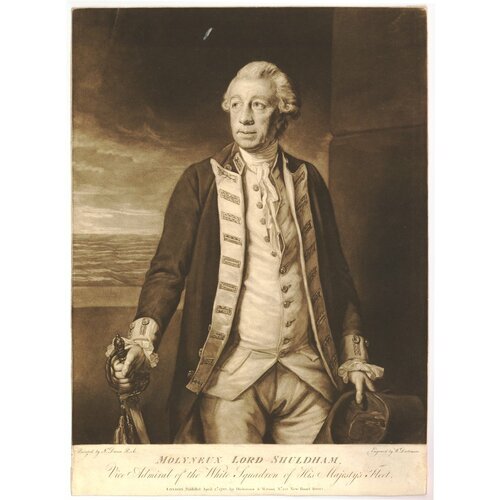As part of the funding agreement between the Dictionary of Canadian Biography and the Canadian Museum of History, we invite readers to take part in a short survey.

Source: Link
SHULDHAM, MOLYNEUX, 1st Baron SHULDHAM, naval officer and governor of Newfoundland; b. c. 1717, probably in Ireland, second son of the Reverend Lemuel Shuldham and Elizabeth Molyneux; m. 4 Oct. 1790 Margaret Irene Sarney; d. 30 Sept. 1798 at Lisbon, Portugal.
Molyneux Shuldham entered the Royal Navy in 1732 as a captain’s servant on the Cornwall. He passed his examination for lieutenant on 25 Jan. 1739 and was promoted captain seven years later. In 1756 his ship, the Warwick, was captured by the French off Martinique and he spent two years as a prisoner in France. Following his release he was given command of the Panther and participated in the capture of Guadeloupe in 1759.
After holding peacetime commands in home waters, in February 1772 Shuldham succeeded John Byron as governor of Newfoundland. Upon his arrival he investigated the fortifications at St John’s and Placentia and found them greatly deteriorated. The home government subsequently ordered the construction of a new fort at St John’s, and Shuldham, after consultation with the chief engineer, Lieutenant Robert Pringle, decided to locate it on the crest of the hill at the rear of the town. When completed in 1780, Fort Townshend became the seat of government on the island.
During the 18th century, Newfoundland’s administration was characterized by an absence of any real local government, and much of Shuldham’s time before his return to England in the fall each year was taken up with issuing proclamations and deciding disputes. He also did his best to uphold the sometimes shaky authority of local officials. When the St John’s justices of the peace complained in 1772 that two merchants had failed to obey summonses and had threatened to crop the ears of the first constables who meddled with them, Shuldham replied soothingly that he would always support the justices to the utmost of his power but that the persons complained of should be treated with that “decency and indulgence to which they are entitled as gentlemen, merchants, and British subjects.”
In August 1773 Shuldham visited the Labrador coast, which had been placed under the jurisdiction of the governor of Newfoundland in 1763. At Chateau Bay he issued a proclamation which gave British fishing firms greater security in their posts, and he dispatched “a very sensible officer,” Lieutenant Roger Curtis*, to explore the northern coast and visit the Moravian missionaries at their newly established station at Nain [see Christian Larsen Drachart]. Curtis’ lengthy reports praised the Moravians’ progress with the Inuit and extolled the potential of the northern fisheries. Shuldham himself sent much information to the British government concerning fishing posts and good harbours in southern Labrador. Although his authority over the coast ended when Labrador was reannexed to Quebec in 1774, Shuldham continued to superintend the fisheries as commander-in-chief of the squadron detailed for their protection.
In February 1775 Shuldham was succeeded as governor by Commodore Robert Duff; he was promoted rear-admiral on 31 March and the following September became commander-in-chief of the North American station. His force was not large enough to give protection to all the colonies, however, and he was unable to send Commodore Mariot Arbuthnot in Nova Scotia and Administrator Phillips Callbeck in St John’s (Prince Edward) Island the ships they wanted. On 17 March 1776 Shuldham evacuated the army of Lieutenant-General Sir William Howe and several thousand loyalist refugees from Boston, arriving safely at Halifax with the transports on 2 April. He now considered that Nova Scotia had become more important and urged the Admiralty to provide additional warships to guard the province. When he convoyed Howe’s army to New York in June he left ships behind in the Bay of Fundy and off Cape Breton Island. The following month he was suddenly superseded by Vice-Admiral Richard, Viscount Howe but the blow was eased when he was created an Irish baron. Shuldham’s active career was now effectively at an end, although he served as admiral of Plymouth dockyard from 1777 to 1782 and represented Fowey in parliament from 1774 to 1784. He became a full admiral in 1787. Married late in life, he had no children.
In Newfoundland, Shuldham was reasonably successful in a demanding post, and if he did not display any great initiative he carried out his instructions conscientiously. His interest in Labrador resulted in the first detailed information about the northern coast. On the North American station he handled the operations of his squadron competently and withdrew quietly when replaced by Howe. Although the defence of Canada was necessarily at the edge of his concern, he nevertheless recognized the importance of Halifax and took what means he could to protect Nova Scotia.
[Molyneux Shuldham], The despatches of Molyneux Shuldham, vice-admiral of the blue and commander-in-chief of his Britannic majesty’s ships in North America, January-July 1776, ed. R. W. Nesser (New York, 1913).
PANL, GN2/1, 27 July, 2, 5, 15, 16 Oct. 1772; 21 Aug., 13, 15 Oct. 1773. PRO, Adm. 1/470, 1/484, 2/550; CO 5/119, 5/205, 5/251, 194/30–32, 199/17; WO 1/2. Gentleman’s Magazine, 1798, 909. [J.] B. Burke, A genealogical history of the dormant, abeyant, forfeited and extinct peerages of the British empire (3rd ed., London, 1883). Charnock, Biographia navalis, V, 505–8. DNB. A. [C.] Valentine, The British establishment, 1760–1784 . . . (2v., Norman, Okla., 1970), II, 790.
Cite This Article
William H. Whiteley, “SHULDHAM, MOLYNEUX, 1st Baron SHULDHAM,” in Dictionary of Canadian Biography, vol. 4, University of Toronto/Université Laval, 2003–, accessed March 29, 2025, https://www.biographi.ca/en/bio/shuldham_molyneux_4E.html.
The citation above shows the format for footnotes and endnotes according to the Chicago manual of style (16th edition). Information to be used in other citation formats:
| Permalink: | https://www.biographi.ca/en/bio/shuldham_molyneux_4E.html |
| Author of Article: | William H. Whiteley |
| Title of Article: | SHULDHAM, MOLYNEUX, 1st Baron SHULDHAM |
| Publication Name: | Dictionary of Canadian Biography, vol. 4 |
| Publisher: | University of Toronto/Université Laval |
| Year of revision: | 1979 |
| Access Date: | March 29, 2025 |



